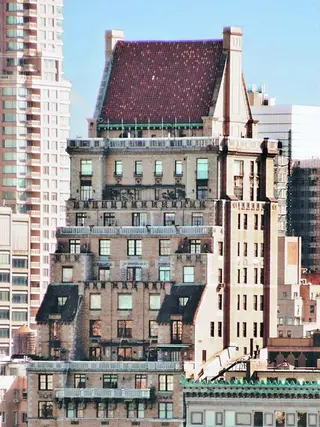 Carter Horsley
Carter HorsleyDec 23, 2011
Carter's Review
One of the most attractive residential buildings on Fifth Avenue, this 23-story tower at 825 Fifth Avenue between 63rd and 64th Streets was erected in 1926 and its red-tiled, hipped roof has since been a key element on the avenue’s skyline facing the park.
It was designed by J. E. R. Carpenter, the foremost apartment building architect of his day whose other buildings on the avenue include numbers 810, 845, 907, 920, 950, 988, 1030, 1060, 1115, 1120, 1143, 1150, 1165 and 1170.
The building was erected in 1927 as a cooperative with 77 apartments, but it now has 64 units.
Bottom Line
One of the handsomest pre-war apartment buildings on the avenue, it has many relatively small apartments for such a prime location.
Description
The base of the building is very ornate and handsome and the tall, steep roof is particularly striking because the red tiles are only on the east and west façades and are framed by small chimneys.
The building's location is ideal and very close to Midtown. About the only drawback to the building is the number of parades that pass by, but that goes with the Fifth Avenue territory.
Amenities
The building has a doorman and a concierge, a canopied entrance and sidewalk landscaping, hotel and maid service, a laundry room and private storage. Pets are allowed and there is a live-in superintendent.
Apartments
With five apartments per floor, the building has smaller units than many other luxury apartment buildings of its era on the avenue.
Am earlier scheme for the building called for a medieval castellated form, according to Andrew Alpern’s excellent book, “The New York Apartment Houses of Rosario Candela and J. E. R. Carpenter, “but was revised to a more conventional classical façade.
Mr. Alpern also noted that from 1947 to 1950, “service pantries legalized as cooking spaces, effectively converting this apartment hotel to an apartment house.”
A two-bedroom unit has a 12-foot-long entrance hall that leads to an 11-foot-wide elliptical library that leads to 21-foot-long north and south living rooms. The apartment also has a 9-foot-wide kitchen.
Apartment 11DE is a two-bedroom unit that has a 14-foot-wide entry foyer that opens onto a 45-foot-wide living room with a 45-foot-long terrace. The apartment has a 12-foot-long enclosed kitchen.
Apartment 15D has is a one-bedroom unit that has a 19-foot-long living room that opens onto a 15-foot-wide sun room flanked by 13-foot-long terraces. It also has a 19-foot-long library and an 11-foot-long kitchen.
A two-bedroom unit has front and back terraces, a 25-foot-long salon with a fireplace next to a 12-foot-long, enclosed kitchen.
The typical floor has a one-bedroom apartment with a long entry hall leading to a 17-foot-long foyer, a 9-foot-long dining alcove and a 24-foot-long living room, a two-bedroom apartment with the same layout, a one-bedroom unit with a 12-foot-long entry foyer leading to a 24-foot-long living room. In the rear were two one-bedroom unit with long entry halls leading to a 7-foot-long foyers, and 20-foot-wide living room.
Needless to say, the building has great views.

- Co-op built in 1927
- 4 apartments currently for sale ($1.25M to $37M)
- Located in Park/Fifth Ave. to 79th St.
- 64 total apartments 64 total apartments
- 10 recent sales ($1.5M to $5.5M)
- Doorman

 6sqft delivers the latest on real estate, architecture, and design, straight from New York City.
6sqft delivers the latest on real estate, architecture, and design, straight from New York City.
